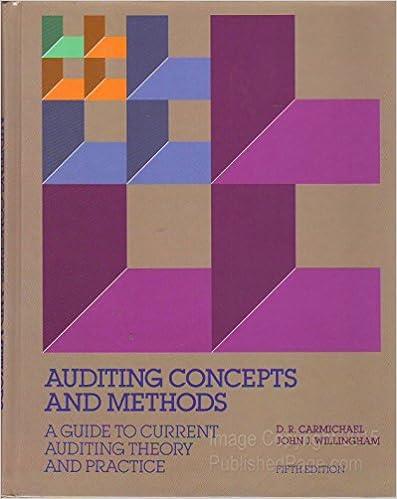You are finishing your audit of the financial statements of Pecan Corporation for the year ended September
Question:
You are finishing your audit of the financial statements of Pecan Corporation for the year ended September 30, 19X4. The corporation's report to stockholders, which will include your standard report, will contain the consolidated financial statements of Pecan and its substantial subsidiary, Oak Corporation. This is your third annual audit of Pecan, and you find that the following changes from the prior year have occurred:
1. Oak, which is located in another state, was acquired as a subsidiary during 19X4. Another independent auditor, who was engaged by the client, rendered an unqualified opinion on Oak financial statements for the year ended September 30, 19X4. While you are willing to use the report for the purpose of expressing your opinion on the consolidated statements, you are unwilling to assume responsibility for the performance of the work which served as the basis for the opinion. You have reviewed the accounting procedures employed by the client to prepare the consolidated statements and approve of them. The corporation has appended to its financial statements a footnote that explains adequately the time of acquisition and the method of consolidation.
2. In accordance with your suggestion, on October 1, 19X3, for the 19X4 fiscal year Pecan had begun the procedure of estimating its total social security taxes expense for the calendar year and then allocating the total to monthly costs and expenses on the basis of the proportion of total estimated annual payroll actually earned each month. In prior years this tax expense was charged to costs and expenses in the same months that the related taxable wages were paid. The unallocated social security taxes expense on taxable wages earned through September 30, 19X4 amounted to \($20,000\) before consideration of income tax effect. (The income tax rate is 50 percent.) Oak uses the same method of accounting for social security taxes as Pecan adopted.
3. For 19X4 Pecan changed its policy of taking a complete physical inventory at September 30 to taking physical inventories of half the inventory on July 31, the other half on August 31. You were consulted on this change and approved it. Your observation of the two physical inventories and your other procedures produced no exceptions as to quantities.
4. A new customer of Pecan is a retail chain store company whose accounting system makes it unable to confirm the \($56,000\) balance of its account. You exam- ined related remittances by this customer totaling \($50,000\) in post-balance-sheet- date audit procedures and satisfied yourself regarding the balance by examination of shipping documents, with the exception that there is a \($200\) charge in dispute, which you considered immaterial. The \($56,000\) is net of a credit memorandum of \($150.\)
5. Your post-balance-sheet-date audit procedures disclosed that Pecan Corp. is considering shutting down, on December 31, 19X4, a division that has been a marginal operation. Because of the possible effect on stockholder and employee relations, management prefers not to make a disclosure of its consideration of the proposed shutdown in the annual report, which will probably be mailed to stockholders on November 15.
6. A number of substantial claims and lawsuits, which were given widespread publicity, were filed in 19X4 against Pecan for damages alleged to have resulted from the use of certain products sold in 19X3. The line of products was discontinued early in 19X4. The corporation's attorney is unable to predict the outcome of these claims and lawsuits. The management of the corporation believes that losses, if any, incurred in excess of the product liability insurance coverage would not have a material effect upon the company's financial position. The scope of your audit of Pecan was not limited by the client in any way. No other items of importance were uncovered by your audit.
a. Prepare the additional notes that you would suggest that the client should append to the financial statements.
b. For each of the listed changes that you think does not require disclosure, justify your belief.
c. Assuming that the client adopts your recommended notes, prepare the auditor's report.
Step by Step Answer:

Auditing Concepts And Methods A Guide To Current Auditing Theory And Practice
ISBN: 9780070099999
5th Edition
Authors: Mcgraw-Hill





